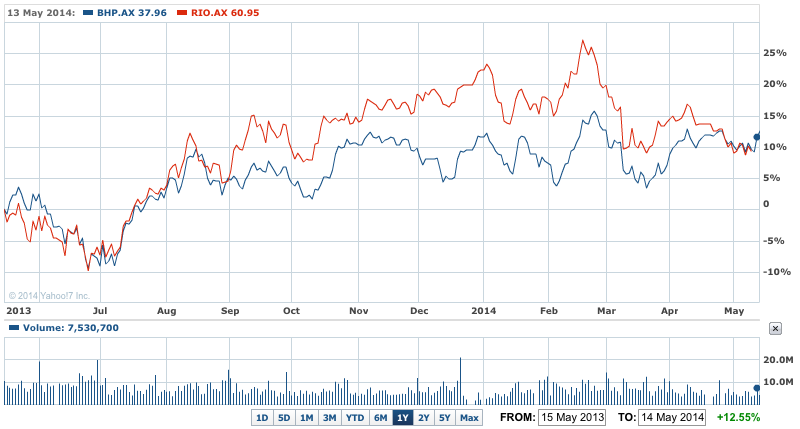Big things seem to be happening within BHP Billiton (BHP) and Rio Tinto (RIO), judging by several announcements and speeches yesterday.
BHP revealed late in the day that it had started reviewing its nickel business and confirmed media reports that it had set up a new company to house its aluminium related assets.
On top of that, BHP CEO Andrew Mackenzie made it clear that company was pushing on with improving efficiencies and cost cutting.
And Rio Tinto’s CEO Sam Walsh indicated that while the company was also still on a cost cutting course, shareholders might hear of some news on higher payouts, and new mining developments early in 2015.
The news had little impact on the share prices of the two giants, but it does seem that BHP in particular, is starting to restructure itself and perhaps move towards a spin off of low yielding assets.
This would be part of creating a number of discrete businesses, concentrated on iron ore, coal, petroleum, copper and perhaps potash.
BHP shares ended on $38.30, up nearly 0.9% (and the share price rose after the nickel review announcement in late trading).
Rio Tinto shares lost 0.1% to $62.78, which is hardly any movement at all.
BHP vs RIO 1Y – BHP, Rio hint at big changes

The key announcement from BHP was the review of its Western Australian Nickel West business.
That comprises the Mt Keith, Cliffs and Leinster mines and associated concentrators, the Kalgoorlie smelter, Kambalda concentrator and the Kwinana refinery near Perth.
They are essentially the old nickel assets of Western Mining which BHP took over near a decade ago.
BHP said the review "is considering all options for the long-term future of Nickel West, including the potential sale of all or parts of the business, and follows the decision to cease operations in the sub-level cave at Perseverance Underground mine due to safety concerns in December 2013”.
Nickel West Asset President Paul Harvey, said in the statement: “Nickel West is one of the world’s leading nickel producers. Our reputation is proudly built on the commitment and calibre of our people, and the support of our communities and stakeholders.
“Our focus on working safely and continuing to find and deliver ways to improve the competitiveness of our business is unchanged.
"The review of the Nickel West business is consistent with the Company’s long held practice of continually reviewing its operations, although it will only pursue options that maximise value for BHP Billiton shareholders.
"Any potential course of action remains subject to detailed analysis and an assessment of alternatives," BHP added.
Nickel is the best performing commodity so far this year with prices up 50% or more (to new two year highs) because of a ban on Indonesian exports of ore and concentrates, plus the possible impact on Russian exports from the tensions in Ukraine.
That might make the Nickel West easier to sell, or harder to part with for BHP.
That came several hours after it became known that BHP had created a new Australian company for its aluminium assets.
Fairfax Media reports that BHP Billiton Aluminium (Holdings) Pty Ltd was created May 6 and registered at BHP’s Perth office.
Brisbane-based BHP Coal Holdings is its sole shareholder, however BHP is the ultimate holding company and Fairfax said it was it unclear whether BHP Billiton Aluminium retains any physical assets.
But there’s obviously a work agenda within BHP for some significant change, given in the nickel move and continuing talk of the spin off of the company’s aluminium alumina and bauxite assets, some thermal coal assets, the Groote Eylandt manganese mine and the nickel and silver mining and processing facilities.
These sorts of reviews and new company structures do not happen without a purpose.
Overnight Tuesday BHP CEO Andrew MacKenzie made it clear he saw a reason for revamping the company’s structure and assets.
He told a mining conference in the US that the case for further simplification of the business was "compelling".
He said no decisions had been made and indicated the outcome may not be known until BHP’s annual results in August.
"The case for the continued simplification of our portfolio is compelling and it remains our priority," he was quoted as saying in a release.
"Simplification will create a portfolio of unrivalled quality and be the catalyst for increased and accelerated productivity gains. Value is our priority, and we will get it right.”
And Rio CEO Sam Walsh suggested that the company’s shareholders could see some progress on high payouts and new projects early in 2015.
He also told the same conference that the company’s Pilbara iron ore business in WA is now consistently producing at a rate of 290 million tonnes per year.
Rio produced 266 million tonnes in 2013 and shipped 259 million tonnes.
The expansion to 290 million tonnes was due for completion in late June, and Rio says it has plans to expand to a maximum of 350 million tonnes by 2017.
He made no comment on the slide in iron ore prices towards $US100 a tonne this year (down more than 20%).
And then he tantalisingly suggested that there could be something for shareholders in the next year, as well as possible new projects.
"I am about creating options for the board. We will have the options in February next year, when we look at our dividend policy and I guess the combination of growth and dividends,” he was quoted as saying.
”We are planning that in 2015 we will have about $US8 billion of capital (spending), if we were to commit to additional growth projects in February next year we would not expect to see (it) flow through in 2015," he said, adding that the actual spending would happen in the years after 2015.
Mr Walsh recently named the La Granja copper project in Peru, the Resolution copper project in Arizona and Australia’s South of Embley bauxite project on Cape York in Queensland as Rio’s top three development prospects.













